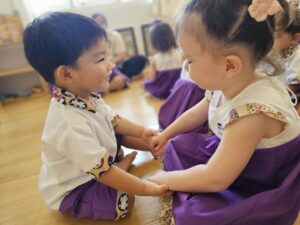Our theme for Term 4 is centered around the exploration of human organs and skeletons, providing an excellent opportunity for teachers, parents, and children to learn more about the wonders of the human body.
To facilitate this learning, our Mount Sophia campus has created a science corner which children can explore and learn more about the topic.

The science corner is a place where children can have fun and learn at the same time. By encouraging our children to ask questions and explore their interests, we are helping them grow their understanding of how the human body works in a way that is fun and engaging.
Learning body parts is important for early learning because it allows children to start developing a sense of body awareness. Body awareness is the ability to recognize where your body is in space and how it moves.
This is how we described the various body parts they were learning to the children:
- Brain – the brain is where thoughts and feelings come from. It controls the muscles, as well as some actions such as breathing and heartbeat, which take place without us having to think.
- Skeleton and bones – is a frame of joined-up bones that shape a body.
- Lungs – air containing a gas called oxygen is breathed in and fills the lungs, which inflate like a balloon. Blood flowing through the lungs collects the oxygen. As waste gases are breathed out, the lungs deflate and get smaller
- Stomach and Intestine – The stomach is stretchy, bag-like body parts that food goes into after it is eaten. Muscles in the stomach move to break down the food and turn it into mush.
- Joints – joints such as ankles, elbows and hips are where bones join together and allow the body to bend
- Heart – the heart muscle that beats non-stop to pump blood around the body. Blood flows through tubes called arteries and veins.
Here are some activities that the children have been exploring in the science corner:

- Build a skeleton model. This is a great way to learn about the different bones in the human body and how they fit together. You can use a variety of materials to build your model, such as pipe cleaners, marshmallows, and toothpicks.
- Draw or paint a diagram of the human body. This is a fun and creative way to learn about the different parts of the body and how they work together. You can label the different organs and systems, or you can draw a more detailed diagram of a specific part of the body, such as the heart or the brain.
- Make a model of a cell. Cells are the building blocks of the human body, so it’s important to learn about them. You can use a variety of materials to make a cell model, such as clay, Jell-O, or even candy.
- Play games and do puzzles about the human body. There are many different books, games and puzzles available that can help children learn about the human body in a fun and engaging way. One great book to check out is The Human Body – Shine-A-Light by Carron Brown and Rachel Saunders, our book of the term. There are lots of books that are age appropriate and include fun and interesting ways for children to learn about the human body.

Our parents, teachers and children have been enjoying reading books in the science corner about the human body to help them better understand how it is all connected.
There are many great resources available to help children learn about the human body. You can find books and articles at your local library or bookstore, or you can search online too!
These hands-on learning activities are fantastic ways to start introducing how amazing the human body is. Try them out together at home!








